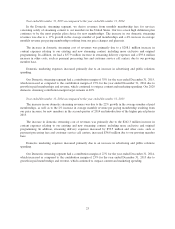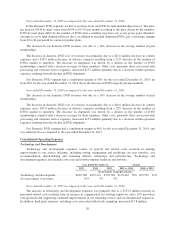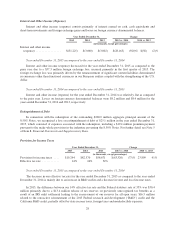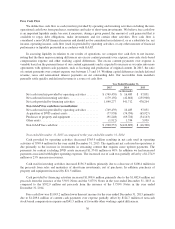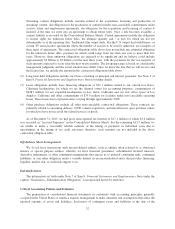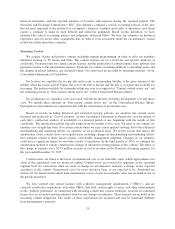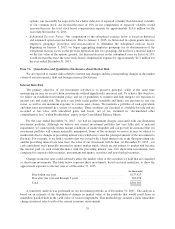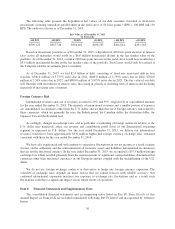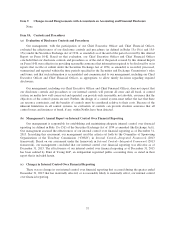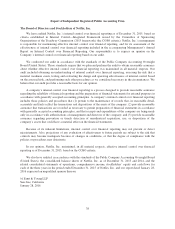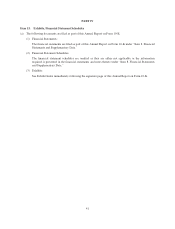NetFlix 2015 Annual Report Download - page 37
Download and view the complete annual report
Please find page 37 of the 2015 NetFlix annual report below. You can navigate through the pages in the report by either clicking on the pages listed below, or by using the keyword search tool below to find specific information within the annual report.financial statements, and the reported amounts of revenues and expenses during the reported periods. The
Securities and Exchange Commission (“SEC”) has defined a company’s critical accounting policies as the ones
that are most important to the portrayal of a company’s financial condition and results of operations, and which
require a company to make its most difficult and subjective judgments. Based on this definition, we have
identified the critical accounting policies and judgments addressed below. We base our estimates on historical
experience and on various other assumptions that we believe to be reasonable under the circumstances. Actual
results may differ from these estimates.
Streaming Content
We acquire, license and produce content, including original programming, in order to offer our members
unlimited viewing of TV shows and films. The content licenses are for a fixed fee and specific windows of
availability. Payment terms for certain content licenses and the production of content require more upfront cash
payments relative to the amortization expense. Payments for content, including additions to streaming assets and
the changes in related liabilities, are classified within “Net cash (used in) provided by operating activities” on the
Consolidated Statements of Cash Flows.
For licenses we capitalize the fee per title and record a corresponding liability at the gross amount of the
liability when the license period begins, the cost of the title is known and the title is accepted and available for
streaming. The portion available for streaming within one year is recognized as “Current content assets, net” and
the remaining portion as “Non-current content assets, net” on the Consolidated Balance Sheets.
For productions we capitalize costs associated with the production, including development cost and direct
costs. We include these amounts in “Non-current content assets, net” on the Consolidated Balance Sheets.
Participations and residuals are expensed in line with the amortization of production costs.
Based on factors including historical and estimated viewing patterns, we amortize the content assets
(licensed and produced) in “Cost of revenues” on the Consolidated Statements of Operations, over the shorter of
each title’s contractual window of availability or estimated period of use, beginning with the month of first
availability. The amortization period typically ranges from six months to five years. For most of our content, we
amortize on a straight-line basis. For certain content where we expect more upfront viewing, due to the additional
merchandising and marketing efforts, we amortize on an accelerated basis. We review factors that impact the
amortization of the content assets on a regular basis, including changes in merchandising and marketing efforts.
Our estimates related to these factors require considerable management judgment. Changes in our estimates
could have a significant impact on our future results of operations. In the third quarter of 2015, we changed the
amortization method of certain content given changes in estimated viewing patterns of this content. The effect of
this change in estimate was a $25.5 million increase in cost of revenues in the Domestic streaming segment, for
the year ended December 31, 2015.
Content assets are stated at the lower of unamortized cost or net realizable value, which approximates fair
value of the capitalized costs for produced content. Content assets are reviewed in aggregate at the operating
segment level for write-down when an event or change in circumstances indicates a change in the expected
usefulness of the content. Unamortized costs for assets that have been, or are expected to be, abandoned are
written off. No material write-down from unamortized cost to a lower net realizable value was recorded in any of
the periods presented.
We have entered into certain licenses with collective management organizations (“CMOs”), and are
currently involved in negotiations with other CMOs, that hold certain rights to music and other entertainment
works “publicly performed” in connection with streaming content into various territories. Accruals for estimated
license fees are recorded and then adjusted based on any changes in estimates. These amounts are included in the
streaming content obligations. The results of these negotiations are uncertain and may be materially different
from management’s estimates.
33


